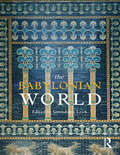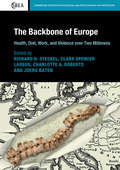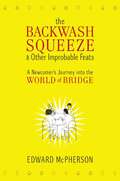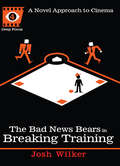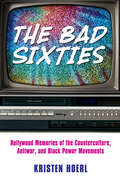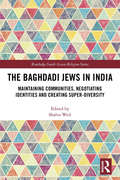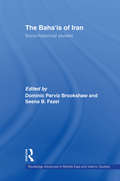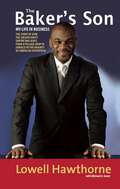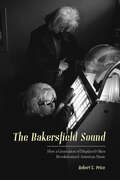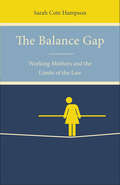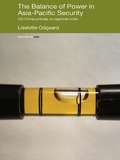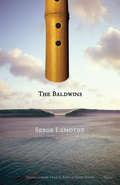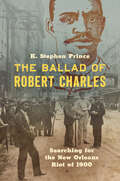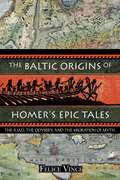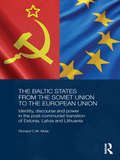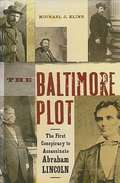- Table View
- List View
The Babylonian World (Routledge Worlds)
by Gwendolyn LeickThe Babylonian World presents an extensive, up-to-date and lavishly illustrated history of the ancient state Babylonia and its 'holy city', Babylon. Historicized by the New Testament as a centre of decadence and corruption, Babylon and its surrounding region was in fact a rich and complex civilization, responsible for the invention of the dictionary and laying the foundations of modern science. This book explores all key aspects of the development of this ancient culture, including the ecology of the region and its famously productive agriculture, its political and economic standing, its religious practices, and the achievements of its intelligentsia. Comprehensive and accessible, this book will be an indispensable resource for anyone studying the period.
The Babylonian World (Routledge Worlds)
by Gwendolyn LeickThe Babylonian World presents an extensive, up-to-date and lavishly illustrated history of the ancient state Babylonia and its 'holy city', Babylon.Historicized by the New Testament as a centre of decadence and corruption, Babylon and its surrounding region was in fact a rich and complex civilization, responsible for the invention of the dictionary and laying the foundations of modern science. This book explores all key aspects of the development of this ancient culture, including the ecology of the region and its famously productive agriculture, its political and economic standing, its religious practices, and the achievements of its intelligentsia.Comprehensive and accessible, this book will be an indispensable resource for anyone studying the period.
The Backbone of Europe: Health, Diet, Work and Violence over Two Millennia (Cambridge Studies in Biological and Evolutionary Anthropology #80)
by Clark Spencer Larsen Joerg Baten Richard H. Steckel Charlotte A. RobertsUsing human skeletal remains, this volume traces health, workload and violence in the European population over the past 2,000 years. Health was surprisingly good for people who lived during the early Medieval Period. The Plague of Justinian of the sixth century was ultimately beneficial for health because the smaller population had relatively more resources that contributed to better living conditions. Increasing population density and inequality in the following centuries imposed an unhealthy diet - poor in protein - on the European population. With the onset of the Little Ice Age in the late Middle Ages, a further health decline ensued, which was not reversed until the nineteenth century. While some aspects of health declined, other attributes improved. During the early modern period, interpersonal violence (outside of warfare) declined possibly because stronger states and institutions were able to enforce compromise and cooperation. European health over the past two millennia was hence multifaceted in nature.
The Backwash Squeeze & Other Improbable Feats: A Newcomer's Journey into the World of Bridge
by Edward McPhersonThere is one card game that towers above all others as the most intelligent, intricate, and psychologically absorbing ever to be invented. It has a rich history. It's played and loved by some of the world's most famous and influential people. And it's not the one that's currently on television twenty-four hours a day.In 1925 Harold Stirling Vanderbilt invented modern bridge, and a national craze was born. In the 1930s, bridge was even bigger than baseball. Its devotees would eventually include the Marx Brothers, George Burns, Wilt Chamberlain, Mahatma Gandhi, Winston Churchill, and Gen. Dwight D. Eisenhower, who played to unwind before the Normandy invasion. Today bridge players number about twenty-five million in the U.S. alone; current celebrity addicts include Warren Buffett (who goes by the online handle "T-Bone"), Bill Gates, Hugh Hefner, Sting, a sitting Supreme Court justice, and the guys from Radiohead.In this spirited homage, Edward McPherson recounts the history of the game while attempting to master its deep mysteries in time to compete at the North American Bridge Championships in Chicago. Barely able to shuffle cards let alone play bridge, he sets out to discover why the game became and remains such a popular pastime, stopping in Dallas, Kansas City, Gatlinburg, Gettysburg, Las Vegas, and London. He focuses on a handful of professionals and eager but fumbling amateurs, and the characters he meets convince him that in a game that pits mind against mind, close attention to the cards often reveals much about those sitting at the table. He attempts to learn from bridge's devoted fans—from white-haired grannies and international playboys to teenage pros and billionaires—how its legacy can be preserved for future generations. And along the way, he picks up a playing partner of his own: Tina, a New York octogenarian with sharp card skills and energy to burn.Insightful, funny, and steeped in respect for bridge, The Backwash Squeeze and Other Improbable Feats is an affectionate view of a grand game by an outsider trying to make his way into the inner circle.
The Bad News Bears in Breaking Training: A Novel Approach to Cinema (Deep Focus #4)
by Josh Wilker Sean HoweIn 1977, The Bad News Bears in Breaking Training had a moment in the sun. A glowing junk sculpture of American genres-sports flick, coming-of-age story, family melodrama, after-school special, road narrative-the film cashed in on the previous year's success of its predecessor, The Bad News Bears. Arguing against the sequel's dismissal as a cultural afterthought, Josh Wilker lovingly rescues from the oblivion of cinema history a quintessential expression of American resilience and joy.Rushed into theaters by Paramount when the beleaguered film industry was suffering from "acute sequelitis," the (undeniably flawed) movie miraculously transcended its limitations to become a gathering point for heroic imagery drawn from American mythology. Considered in context, the film's unreasonable optimism, rooted in its characters' sincere desire to keep playing, is a powerful response to the political, economic, and social stresses of the late 1970s.To Wilker's surprise, despite repeated viewings, The Bad News Bears in Breaking Training continues to move him. Its huge heart makes it not only the ultimate fantasy of the baseball-obsessed American boy, but a memorable iteration of that barbed vision of pure sunshine itself, the American dream.
The Bad Sixties: Hollywood Memories of the Counterculture, Antiwar, and Black Power Movements (Race, Rhetoric, and Media Series)
by Kristen HoerlWinner of the 2018 Book Award from the American Studies Division of the National Communication AssociationOngoing interest in the turmoil of the 1960s clearly demonstrates how these social conflicts continue to affect contemporary politics. In The Bad Sixties: Hollywood Memories of the Counterculture, Antiwar, and Black Power Movements, Kristen Hoerl focuses on fictionalized portrayals of 1960s activism in popular television and film. Hoerl shows how Hollywood has perpetuated politics deploring the detrimental consequences of the 1960s on traditional American values. During the decade, people collectively raised fundamental questions about the limits of democracy under capitalism. But Hollywood has proved dismissive, if not adversarial, to the role of dissent in fostering progressive social change.Film and television are salient resources of shared understanding for audiences born after the 1960s because movies and television programs are the most accessible visual medium for observing the decade's social movements. Hoerl indicates that a variety of television programs, such as Family Ties, The Wonder Years, and Law and Order, along with Hollywood films, including Forrest Gump, have reinforced images of the "bad sixties." These stories portray a period in which urban riots, antiwar protests, sexual experimentation, drug abuse, and feminism led to national division and moral decay. According to Hoerl, these messages supply distorted civics lessons about what we should value and how we might legitimately participate in our democracy.These warped messages contribute to "selective amnesia," a term that stresses how popular media renders radical ideas and political projects null or nonexistent. Selective amnesia removes the spectacular events and figures that define the late-1960s from their motives and context, flattening their meaning into reductive stereotypes. Despite popular television and film, Hoerl explains, memory of 1960s activism still offers a potent resource for imagining how we can strive collectively to achieve social justice and equality.
The Bad Wife Handbook (Wesleyan Poetry Series)
by Rachel ZuckerRachel Zucker's third book of poems is a darkly comic collection that looks unsparingly at the difficulties and compromises of married life. Formally innovative and blazingly direct, The Bad Wife Handbook cross-examines marriage, motherhood, monogamy, and writing itself. Rachel Zucker's upending of grammatical and syntactic expectations lends these poems an urgent richness and aesthetic complexity that mirrors the puzzles of real life. Candid, subversive, and genuinely moving, The Bad Wife Handbook is an important portrait of contemporary marriage and the writing life, of emotional connection and disconnection, of togetherness and aloneness.
The Badlands Sleuth: Reader (Amplify Core Knowledge Language Arts, Grade 5 #Unit 9)
by Amplify EducationNIMAC-sourced textbook
The Baghdadi Jews in India: Maintaining Communities, Negotiating Identities and Creating Super-Diversity (Routledge South Asian Religion Series)
by Shalva WeilThis book explores the extraordinary differentiation of the Baghdadi Jewish community over time during their sojourn in India from the end of the eighteenth century until their dispersion to Indian diasporas in Israel and English-speaking countries throughout the world after India gained independence in 1947. Chapters on schools, institutions and culture present how Baghdadis in India managed to maintain their communities by negotiating multiple identities in a stratified and complex society. Several disciplinary perspectives are utilized to explore the super-diversity of the Baghdadis and the ways in which they successfully adapted to new situations during the Raj, while retaining particular traditions and modifying and incorporating others. Providing a comprehensive overview of this community, the contributions to the book show that the legacy of the Baghdadi Jews lives on for Indians today through landmarks and monuments in Mumbai, Pune and Kolkata, and for Jews, through memories woven by members of the community residing in diverse diasporas. Offering refreshing historical perspectives on the colonial period in India, this book will be of interest to those studying South Asian Studies, Diaspora and Ethnic Studies, Sociology, History, Jewish Studies and Asian Religion.
The Baha'is of Iran: Socio-Historical Studies (Routledge Advances in Middle East and Islamic Studies)
by Dominic Parviz Brookshaw Seena B. FazelThe Baha’i community of Iran is the country’s largest non-Muslim religious minority. This collection of essays presents a comprehensive study of the social and historical development of the Baha’i community, and its role in shaping modern Iran. Central to this study is the pioneering character of the Baha’i community in the late 19th and early 20th century, with chapters examining the role of women in the Baha’i community; the impact of Baha’i-run schools on Iranian society, Baha’i contributions to public health initiatives; and the influence of Baha’i thought and the actions of individual Baha’is on the Constitutional Revolution of 1906-1911. Conversion to the Baha’i Faith is another important theme, as contributors investigate the phenomenon of large scale conversion to the Baha’i Faith from the Jewish and Zoroastrian communities. Finally, although persecution of the Baha’is has drawn the attention of the Western media, until now few scholars working in the field of Iranian studies have chosen to write on the history or details of this persecution. Here, five prominent figures in the field redress this balance and look at different aspects of this persecution, including its historical background, the attitude of secular Iranians, persecution before and after the Islamic Revolution of 1979, and human rights perspectives. This book will be of interest to students and scholars of Iranian studies, Middle Eastern studies and comparative religion, and with many chapters authored by leading academics in Iranian studies, The Baha’is of Iran addresses both a gap in academic literature on the Baha’i Faith, and in the study of modern Iran in general.
The Baker's Son: My Life In Business
by Lowell HawthorneAn inspirational rags-to-riches memoir by one of the most successful Caribbean-born businessmen living in America. "At 21, Hawthorne's parents shipped him off to New York, where his older siblings had already relocated. He eventually found a job, started college, and began to build the multi-million dollar business Golden Krust, whose Jamaican patties are a New York staple. Hawthorne's story is compelling on many levels: it offers a peek into life in Jamaica, a classic immigrant narrative, and a testament to the strength of family. Hawthorne's is a Horatio Alger tale with a Caribbean flavor, which should find an appreciative audience among entrepreneurs and business aficionados." --Library Journal "The American question gets a great, real-life look in The Baker's Son ... Hawthorne's story is at once inspirational and revelatory." --Publishers Weekly "In his memoir, The Baker's Son, Hawthorne shares how an idea inspired by his father's bakery in Border, Jamaica, grew into the 120-branch Golden Krust Caribbean Bakery and Grill. After 23 years of selling patties, pastries, sandwiches and more through Golden Krust, Hawthorne hasn't lost sight of his values." --New York Daily News "The Baker's Son is a deeply moving account that tells the story of an immigrant family from rural Jamaica that relocated to the Bronx in 1980s... the Hawthorne family has scaled the heights of success to achieve the American Dream to an unprecedented degree." --The Philadelphia Tribune "In gripping narrative that is both inspirational and instructive, Lowell Hawthorne shares how an idea infused with tenacity, intellect, and passion can become a dream realized. The Baker’s Son offers a successful playbook for any entrepreneur who seeks to play on the rough-and-tumble field of business--and win.”--Earl “Butch” Graves, Jr., President and CEO, Black Enterprise "Lowell Hawthorne's chronicle of the development of a small Jamaican business into the highly successful Golden Krust Caribbean Bakery and Grill, an American business empire, is an invaluable guide to business success as well as an inspiring autobiographical work."—P.J. Patterson, former prime minister of Jamaica The Baker's Son is a memoir by the founder of Golden Krust Caribbean Bakery & Grill, the hugely successful Jamaican owned and run enterprise that reaches from New York to Florida with over 120 franchise locations. Starting from humble beginnings, and after weathering several major crises along the way, the Hawthorne family has scaled the heights of success to achieve the American Dream to an unprecedented degree. Today the Golden Krust brand represents the most lucrative Caribbean business ever established in America and one of the most profitable black businesses operating in the United States. Lowell Hawthorne is the president and CEO of Golden Krust Caribbean Bakery & Grill. He lives in Westchester, New York.
The Bakersfield Sound: How a Generation of Displaced Okies Revolutionized American Music
by Robert E. PriceAn immersive look at the country music sub-genre, from its 1950s origins to its heyday to the twenty-first century.In California’s Central Valley, two thousand miles away from Nashville’s country hit machine, the hard edge of the Bakersfield Sound transformed American music during the later half of the twentieth century. Fueled by the steel twang of electric guitars, explosive drumming, and powerfully aching lyrics, the Sound transformed hard times and desperation into chart-toppers. It vaulted displaced Oklahomans like Buck Owens and Merle Haggard to stardom, and even today the Sound’s influence on country music is still widely felt.In this fascinating book, veteran journalist Robert E. Prince traces the Bakersfield Sound’s roots from Dust Bowl and World War II migrations through the heyday of Owens, Haggard, and Hee Haw, and into the twenty-first century. Outlaw country demands good storytelling, and Price obliges; to fully understand the Sound and its musicians we dip into honky-tonks, dives, and radio stations playing the songs of sun-parched days spent on oil rigs and in cotton fields, the melodies of hardship and kinship, a soundtrack for dancing and brawling. In other words, The Bakersfield Sound immerses us in the unique cultural convergence that gave rise to a visceral and distinctly California country music.Praise for The Bakersfield Sound“A savvy blend of personal anecdotes and broader historical narrative.” —Kirkus Reviews“This book all but reads itself. Price’s sense of history, his command of facts, his sense of humor, his sensitivity to class and race, and a love of the music—it’s all here.” —Greil Marcus
The Balance Gap: Working Mothers and the Limits of the Law
by Sarah HampsonIn recent decades, laws and workplace policies have emerged that seek to address the "balance" between work and family. Millions of women in the U.S. take some time off when they give birth or adopt a child, making use of "family-friendly" laws and policies in order to spend time recuperating and to initiate a bond with their children. The Balance Gap traces the paths individual women take in understanding and invoking work/life balance laws and policies. Conducting in-depth interviews with women in two distinctive workplace settings—public universities and the U.S. military—Sarah Cote Hampson uncovers how women navigate the laws and the unspoken cultures of their institutions. Activists and policymakers hope that such family-friendly law and policy changes will not only increase women's participation in the workplace, but also help women experience greater workplace equality. As Hampson shows, however, these policies and women's abilities to understand and utilize them have fallen short of fully alleviating the tensions that women across the nation are still grappling with as they try to reconcile their work and family responsibilities.
The Balance of Power in Asia-Pacific Security: US-China Policies on Regional Order (Politics in Asia)
by Liselotte OdgaardInvestigating the dynamics of balancing patterns in the Asia-Pacific, this book focuses particularly on the contribution of great powers and middle powers to regional stability. Taking the US and China as great powers, and using ASEAN, Russia, Australia and South Korea as example of middle powers, the author addresses the following questions: Do middle powers influence balancing patterns in the Asia-Pacific? Are the United States and China balancing each other in the Asia-Pacific, and if so, by which means? What is the contribution of the English school to understanding balance of power dynamics? The Balance of Power in Asia-Pacific Security makes a persuasive contribution to the debate on the US-China relationship. Interviews with policy practitioners and academics in the region offer a systematic analysis of the complexities of Asia-Pacific security. Providing conceptual insights, this book gives a fresh understanding of the mechanisms necessary to maintain regional stability and explains the implications of US-China power balancing for global security. It will be an important resource for scholars and students of Asia-Pacific politics and security.
The Baldwins
by David Homel Fred A. Reed Serge LamotheIn the post-apocalyptic future, 50 years after the last government of turbo-liberals and its president-for-life have been elected, a group of researchers convenes a Congress to address the curious cultural phenomenon of the Baldwins, whose stories have been gathered and archived by the chroniclers. This novel of fragments represents contemporary prose at its most daring and experimental.
The Ball: Discovering the Object of the Game
by John FoxAnthropologist John Fox sets off on a worldwide adventure to thefarthest reaches of the globe and the deepest recesses of our ancientpast to answer a question inspired by his sports-loving son: "Why do we play ball?"From Mexican jungles to the small-town gridirons of Ohio, frommedieval villages and royal courts to modern soccer pitches andbaseball parks, The Ball explores the little-known origins ofour favorite sports across the centuries, and traces how a simpleinvention like the ball has come to stake an unrivaled claim on ourpassions, our money, and our lives. Equal parts history and travelogue,The Ball removes us from the scandals and commercialism of today'ssports world to uncover the true reasons we play ball, helping us reclaimour universal connection to the games we love.
The Ballad and the Folk (Routledge Library Editions: Folklore)
by David BuchanThe ballad is an enduring and universal literary genre. In this book, first published in 1972, David Buchan is concerned to establish the nature of a ballad and of the people who produced it through a study of the regional tradition of the Northeast of Scotland, the most fertile ballad area in Britain. His account of this tradition has two parallel aims, one specifically literary – to investigate the ballad as oral literature – and one broadly ethnographic – to set the regional tradition in its social context. Dr Buchan applies the interesting and important work which has recently been done on oral tradition in Europe on the relationship of the ballad to society to his study of this particular part of Scotland. He examines a nonliterate society to discover what factors besides nonliteracy helped foster its ballad tradition. He analyses the processes of composition and transmission in the oral ballad, and considers the changes which removed nonliteracy, altered social patterns, and seriously affected the ballad tradition. By demonstrating how people who could neither read nor write were able to compose literature of a high order, David Buchan provides a convincing explanation of the ballad’s perennial appeal and an answer to the ‘ballad enigma’. His book is also a valuable study in social history of this culturally distinct region, the Northeast of Scotland.
The Ballad of Danny Wolfe: Life of a Modern Outlaw
by Joe FriesenThe harrowing story of the life and death of the man who founded and ran the first and largest Aboriginal street gang. In 2008, Danny Wolfe, a Winnipeg Aboriginal man, was 31-years-old and awaiting trial on two counts of first-degree murder in at the Regina Correctional Centre. In spite of his young age, it wasn't his first time behind bars -- in fact, Danny had found himself in and out of correctional facilities since his teenage years, sometimes even finding his own way out. Now, fifteen years after his last break out of prison, in an adult facility only a few cells down from his younger brother, Preston, Danny was orchestrating a bold move: a bigger escape from a jail where the notion was inconceivable. Tracing the early years of Daniel Wolfe's life, from his birth in Regina to his mother Susan Creeley, a First Nations woman; to his first brush with the law at the age of four and then his subsequent placement in foster care; to the birth of the Indian Posse -- the Aboriginal street gang in Canada that would eventually claim the title of the largest street gang with over 12,000 members and Danny at the helm; to Danny's death in 2010, Joe Friesen's account of this fascinating character is gripping and provocative.From the Hardcover edition.
The Ballad of Robert Charles: Searching for the New Orleans Riot of 1900
by K. Stephen PrinceFor a brief moment in the summer of 1900, Robert Charles was arguably the most infamous black man in the United States. After an altercation with police on a New Orleans street, Charles killed two police officers and fled. During a manhunt that extended for days, violent white mobs roamed the city, assaulting African Americans and killing at least half a dozen. When authorities located Charles, he held off a crowd of thousands for hours before being shot to death. The notorious episode was reported nationwide; years later, fabled jazz pianist Jelly Roll Morton recalled memorializing Charles in song. Yet today, Charles is almost entirely invisible in the traditional historical record. So who was Robert Charles, really? An outlaw? A black freedom fighter? And how can we reconstruct his story? In this fascinating work, K. Stephen Prince sheds fresh light on both the history of the Robert Charles riots and the practice of history-writing itself. He reveals evidence of intentional erasures, both in the ways the riot and its aftermath were chronicled and in the ways stories were silenced or purposefully obscured. But Prince also excavates long-hidden facts from the narratives passed down by white and black New Orleanians over more than a century. In so doing, he probes the possibilities and limitations of the historical imagination.
The Ballad of Roy Benavidez: The Life and Times of America's Most Famous Hispanic War Hero
by William SturkeyThe dramatic life of Vietnam War hero Roy Benavidez, revealing how Hispanic Americans have long shaped US history, from "a major new voice [with] lyrical powers as a biographer&” (David W. Blight, Pulitzer Prize–winning author of Frederick Douglass) In May 1968, while serving in Vietnam, Master Sergeant Roy Benavidez led the rescue of a reconnaissance team surrounded by hundreds of enemy soldiers. He saved the lives of at least eight of his comrades that day in a remarkable act of valor that left him permanently disabled. Awarded the Medal of Honor after a yearslong campaign, Benavidez became a highly sought-after public speaker, a living symbol of military heroism, and one of the country&’s most prominent Latinos. Now, historian William Sturkey tells Benavidez&’s life story in full for the first time. Growing up in Jim Crow–era Texas, Benavidez was scorned as &“Mexican&” despite his family&’s deep roots in the state. He escaped poverty by enlisting in a desegregating military and was first deployed amid the global upheavals of the 1950s. Even after receiving the Medal of Honor, Benavidez was forced to fight for disability benefits amid Reagan-era cutbacks. An unwavering patriot alternately celebrated and snubbed by the country he loved, Benavidez embodied many of the contradictions inherent in twentieth-century Latino life. The Ballad of Roy Benavidez places that experience firmly at the heart of the American story.
The Ballerina and the Bull
by Johanna IsaacsonOur moment has seen the resurgence of an anarchist sensibility, from the uprisings in Seattle in 1999 to the Occupy movement of 2011. Against the vacuity and drift of financialized capitalism, proclaiming there is no alternative, these insurgent movements have insisted that an alternative is possible. In The Ballerina and the Bull Johanna Isaacson explores the occult history of US punk, hardcore, queercore, and riot grrrl, DIY culture, and alternative subcultures to trace a new politics of expressive negation that both contests the present order and gives us a sense of the impasses of politics in an age of depoliticization. Expressive negation registers the contradictory politics at the heart of these projects: the desire for negation that must be positively expressed. Drawing on first- hand experience, interviews, and discussion of the ludic, spatial, and sexual politics of anarchist subcultures, Isaacson maps an underground utopian politics of style and develops a radically new history of the present moment.From the Trade Paperback edition.
The Ballets Russes and beyond
by Davinia Caddy"Belle-époque Paris witnessed the emergence of a vibrant and diverse dance scene, one that crystallized around the Ballets Russes, the Russian dance company formed by impresario Sergey Diaghilev. The company has long served as a convenient turning point in the history of dance, celebrated for its revolutionary choreography and innovative productions. This book presents a fresh slant on this much-told history. Focusing on the relation between music and dance, Davinia Caddy approaches the Ballets Russes with a wide-angled lens that embraces not just the choreographic, but also the cultural, political, theatrical and aesthetic contexts in which the company made its name. In addition, Caddy examines and interprets contemporary French dance practices, throwing new light on some of the most important debates and discourses of the day"--
The Baltic Origins of Homer's Epic Tales: The Iliad, the Odyssey, and the Migration of Myth
by Felice VinciCompelling evidence that the events of Homer's Iliad and Odyssey took place in the Baltic and not the Mediterranean• Reveals how a climate change forced the migration of a people and their myth to ancient Greece • Identifies the true geographic sites of Troy and Ithaca in the Baltic Sea and Calypso's Isle in the North Atlantic OceanFor years scholars have debated the incongruities in Homer's Iliad and Odyssey, given that his descriptions are at odds with the geography of the areas he purportedly describes. Inspired by Plutarch's remark that Calypso's Isle was only five days sailing from Britain, Felice Vinci convincingly argues that Homer's epic tales originated not in the Mediterranean, but in the northern Baltic Sea. Using meticulous geographical analysis, Vinci shows that many Homeric places, such as Troy and Ithaca, can still be identified in the geographic landscape of the Baltic. He explains how the dense, foggy weather described by Ulysses befits northern not Mediterranean climes, and how battles lasting through the night would easily have been possible in the long days of the Baltic summer. Vinci's meteorological analysis reveals how a decline of the "climatic optimum" caused the blond seafarers to migrate south to warmer climates, where they rebuilt their original world in the Mediterranean. Through many generations the memory of the heroic age and the feats performed by their ancestors in their lost homeland was preserved and handed down to the following ages, only later to be codified by Homer in the Iliad and the Odyssey.Felice Vinci offers a key to open many doors that allow us to consider the age-old question of the Indo-European diaspora and the origin of the Greek civilization from a new perspective.
The Baltic States from the Soviet Union to the European Union: Identity, Discourse and Power in the Post-Communist Transition of Estonia, Latvia and Lithuania (BASEES/Routledge Series on Russian and East European Studies)
by Richard MoleThe Baltic States are unique in being the only member-states of the EU to have fought to regain their sovereignty from the Soviet Union, only then to cede it to Brussels in certain key areas. Similarly, no member-states have had to struggle as hard as Estonia, Latvia and Lithuania to preserve their identity after fifty years of Soviet nationality policy in the face of sub-state and supra-state challenges. The post-communist experience of the Baltic States thus allows us to examine debates about identity as a source of political power; the conditioning and constraining influence of identity discourses on social, political and economic change; and the orientation and outcome of their external relations. In particular, the book examines the impact of Russian and Soviet control of Estonia, Latvia and Lithuania; the Baltic independence movements of the late 1980s/early 1990s; the citizenship debates; relations with Russia vis-à-vis the withdrawal of the troops of the former Soviet Army; drawing of the shared boundary and the rights of Russian-speaking minorities as well as the efforts undertaken by the three Baltic States to rebuild themselves, modernise their economies, cope with the ensuing social changes and facilitate their accession to the EU and NATO.
The Baltimore Plot: The First Conspiracy to Assassinate Abraham Lincoln
by Michael J. KlineIn January 1861, Abraham Lincoln¿s private train steamed from Illinois to Washington, D.C., where he would be inaugurated as the sixteenth President. However, in Baltimore, a group of Confederate conspirators had formed a plot to assassinate the President-in-waiting when his train made its final stop before Washington. When legendary detective Allan Pinkerton got wind of the plot, he advised Lincoln to remain hidden for the remainder of the journey while he conducted an investigation. However, the case was never brought to trial, leading Lincoln to be ridiculed in the press for cowardice because of which, he vowed never to hide in public again. A promise which, four years later when he sat in full view in the balcony of Ford's Theatre, would cost him his life.
